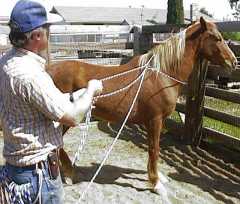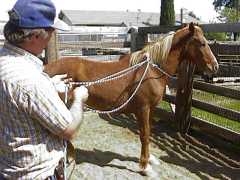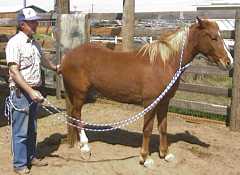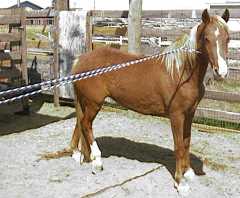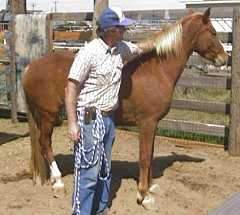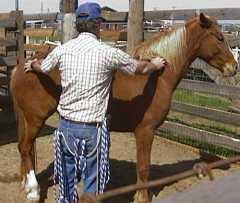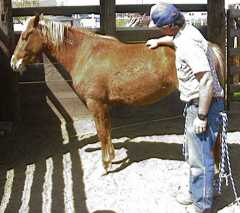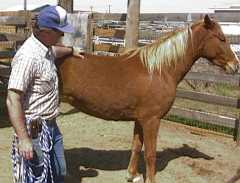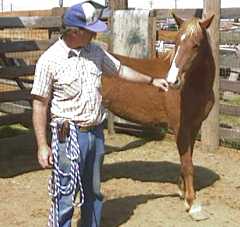The Sliding Neck Loop
| ||||
|
Important Note!
Some of these sequences were photographed decades ago before we participated in a helmet safety study. The results of the study were impressively conclusive. Since 1998 we always wear approved helmets when training and handling horses.
When working your way closer to the horse you can draw your hand up the running part of the line while the hand loop is still in your hand. The hand loop won't suck closed on your fingers if the horse bolts so it is safe to hold on to. Be sure, however, to avoid getting any other part of the rope looped over your hand or arm. If you slide up the rope, double over any excess. Don't make loops of it that you can get caught up in! Start your process by asking the horse to yield toward you from the pressure of the rope. You can reward with release or click, whichever method you prefer. If the horse wants to leave, just stay clear of the hind end and set up your yield again if need be. Don't let the neck loop get closed enough to choke the horse. Leave just enough slack to be comfortable but not so much he can slip his head out. You want to do most of your work on a slack line, only tightening up to yield him to you or to make corrections. If you overdo it and things get out of control, simply let go of the hand loop and the whole rig will undo itself and the horse will be free. Be sure, however, to time your release so the horse doesn't get a foot in the hand loop as it is being taken up. If you handle the horse quietly and correctly, you will discover that you can get up close in relatively no time at all. The "model" for this piece is Shilo, a BLM mare who got her halter off shortly after adoption and managed to keep her adopters at bay. When loading her out to come to the ranch, she tried to jump a pipe panel. She really didn't want to be approached by people except for extending her nose to get a carrot. Her owners did expose her to some clicker training and touching with a bamboo pole. Using a combination of clicker training, the bamboo pole and the neck loop, I was able to get the results shown in the photos with just about an hour's work. I was also able to go back into her pen several times later in the day to rub and brush her. Now at the end of one day this mare still wasn't ready to give me her face, but I could brush or rub her off lead from her butt to her ears, even to the point of rubbing her ears. The sliding neck loop provided some low resistance control so that I could repeatedly get into her space without completely confining her and show her it really wasn't a such bad experience. |
Drawing up the loop
|
Rubbing both ends; usually
|
Working up the other side
|
Still standing quietly
|
Still friends (not traumatized)
|
Continue to Part ThreeReturn to Part OnePress "Back" to return to the page that brought you hereGo to Case Study SectionReturn to Training SectionReturn to Wild Horse MentorsReturn to KBR World of Wild Horses and BurrosGo To
| |

